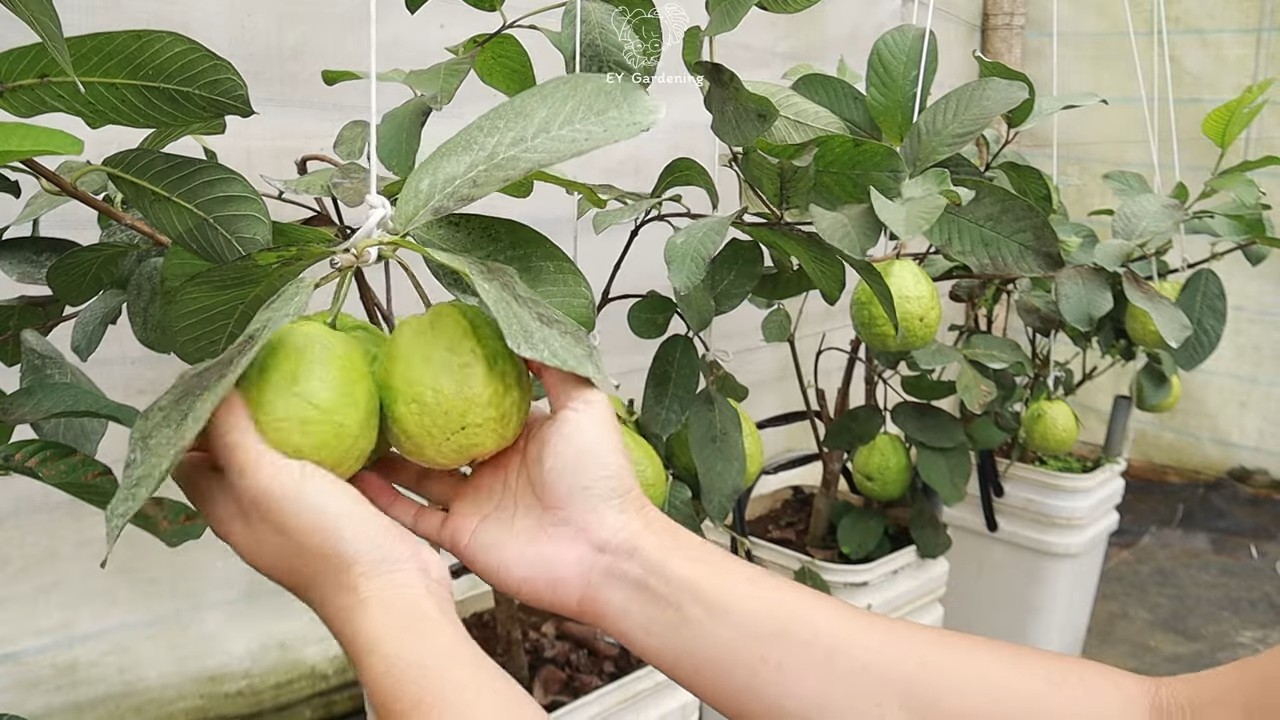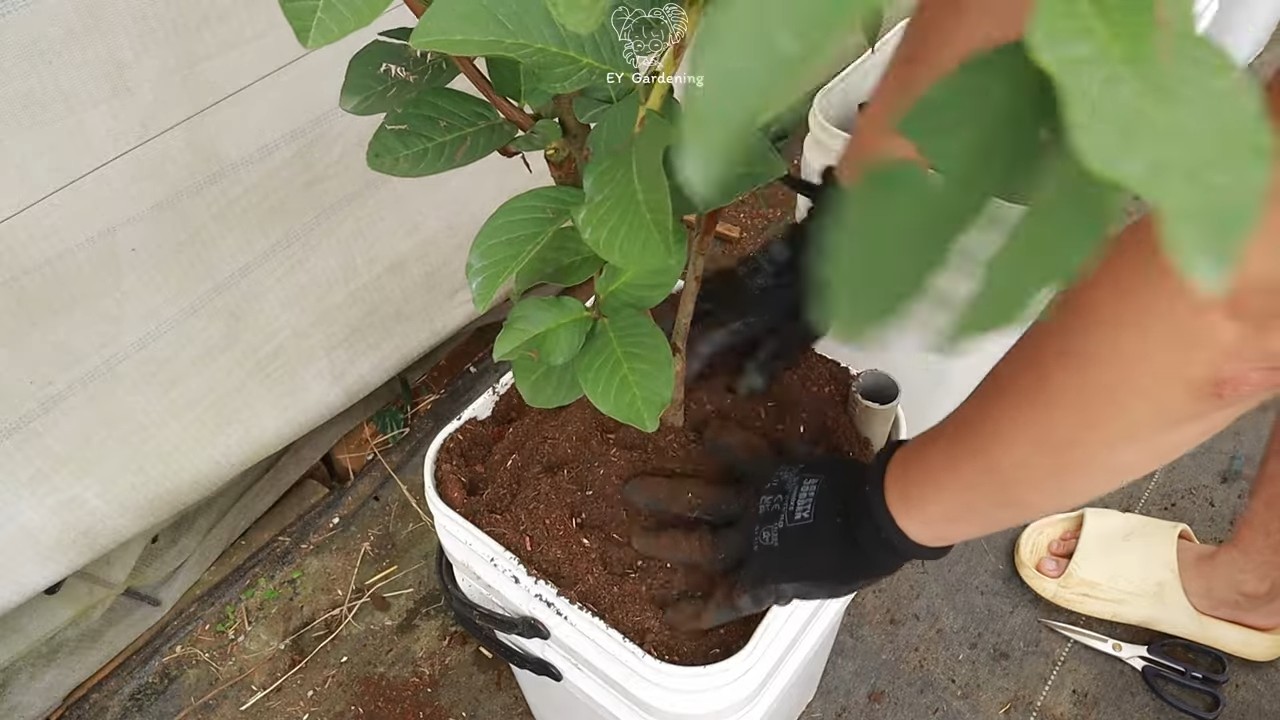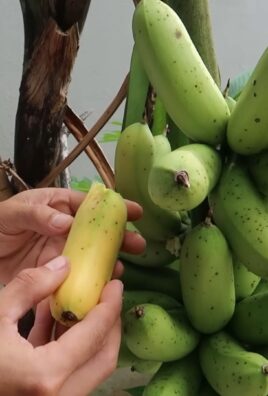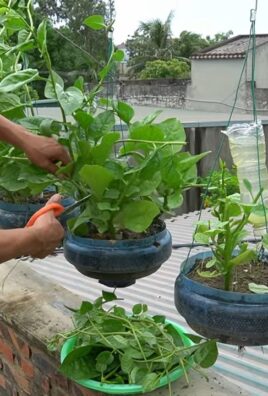Guava Tree Terrace Growing might sound like a tropical dream reserved for sprawling orchards, but guess what? I’m here to tell you that bringing the sweet, tangy goodness of homegrown guavas to your very own terrace is absolutely achievable! Forget those bland, store-bought fruits; imagine plucking a sun-ripened guava right from your own little urban oasis.
For centuries, the guava tree has been cherished across tropical and subtropical regions, not just for its delicious fruit, but also for its medicinal properties and cultural significance. From vibrant street markets in Southeast Asia to backyard gardens in Latin America, the guava tree is a symbol of abundance and natural healing. Now, you can bring a piece of that rich heritage to your home.
Why should you embark on this Guava Tree Terrace Growing adventure? Well, space is often a premium in urban environments, and many of us believe that growing our own food is simply out of reach. But with the right techniques and a little bit of know-how, you can enjoy the satisfaction of nurturing your own guava tree, even on a limited terrace space. Plus, you’ll be reducing your carbon footprint, enjoying fresher, healthier fruit, and adding a touch of exotic beauty to your home. This DIY guide will equip you with the essential tricks and hacks to successfully cultivate a thriving guava tree on your terrace, transforming your outdoor space into a miniature tropical paradise. Let’s get started!

Growing Guava Trees in Pots on Your Terrace: A DIY Guide
Hey there, fellow gardening enthusiasts! Dreaming of fresh, juicy guavas right outside your door? Well, you’ve come to the right place! Growing guava trees in pots on your terrace is totally achievable, and I’m here to guide you through every step. It’s a rewarding experience, and trust me, nothing beats the taste of homegrown guavas. Let’s get started!
Choosing the Right Guava Variety
Not all guava trees are created equal, especially when it comes to container gardening. You’ll want to pick a variety that’s naturally smaller or known for doing well in pots. Here are a few of my favorites:
* Dwarf Guava Varieties: These are specifically bred to stay compact, making them perfect for container growing. Look for names like ‘Nana’ or ‘Red Strawberry Guava’.
* ‘Mexican Cream’ Guava: This variety is known for its delicious, creamy white flesh and manageable size.
* ‘Tropical White’ Guava: Another excellent choice with a sweet, mild flavor and good disease resistance.
* ‘Lemon Guava’: This one has a unique, tangy flavor and tends to stay relatively small.
Important Note: Always check the mature size of the variety you’re considering to ensure it’s suitable for container growing. You don’t want a tree that will quickly outgrow its pot!
Gathering Your Supplies
Before we dive into the planting process, let’s make sure you have everything you need. Here’s a checklist:
* A Large Pot: Choose a pot that’s at least 24 inches in diameter and depth. The bigger, the better, as it will give your guava tree plenty of room to grow. Make sure it has drainage holes!
* High-Quality Potting Mix: Avoid using garden soil, as it can become compacted in pots. Opt for a well-draining potting mix specifically formulated for containers. I like to use a mix of peat moss, perlite, and vermiculite.
* Guava Tree Sapling: Purchase a healthy sapling from a reputable nursery. Look for one with strong branches and vibrant green leaves.
* Slow-Release Fertilizer: This will provide your guava tree with a steady supply of nutrients over time. Choose a fertilizer specifically formulated for fruit trees.
* Watering Can or Hose: For regular watering.
* Pruning Shears: For trimming and shaping your tree.
* Mulch: To help retain moisture and suppress weeds.
* Optional: A trellis or support structure, especially if you’re growing a variety that tends to be a bit sprawling.
Planting Your Guava Tree
Now for the fun part – planting your guava tree! Follow these steps carefully to ensure a successful start:
1. Prepare the Pot: Place a layer of gravel or broken pottery at the bottom of the pot to improve drainage. This will prevent the roots from sitting in water, which can lead to root rot.
2. Add Potting Mix: Fill the pot about one-third full with your high-quality potting mix.
3. Remove the Sapling from its Container: Gently remove the guava tree sapling from its nursery container. Be careful not to damage the roots. If the roots are tightly bound, gently loosen them with your fingers.
4. Position the Sapling: Place the sapling in the center of the pot, making sure the top of the root ball is level with the top of the potting mix.
5. Fill with Potting Mix: Fill the rest of the pot with potting mix, gently tamping it down around the roots.
6. Water Thoroughly: Water the newly planted guava tree thoroughly until water drains out of the drainage holes. This will help settle the soil and ensure the roots are properly hydrated.
7. Add Slow-Release Fertilizer: Sprinkle slow-release fertilizer around the base of the tree, following the instructions on the fertilizer package.
8. Mulch: Apply a layer of mulch around the base of the tree, keeping it a few inches away from the trunk. This will help retain moisture, suppress weeds, and regulate soil temperature.
Caring for Your Potted Guava Tree
Once your guava tree is planted, it’s crucial to provide it with the proper care to ensure it thrives. Here’s what you need to know:
* Watering: Guava trees need regular watering, especially during hot, dry weather. Water deeply whenever the top inch of soil feels dry to the touch. Avoid overwatering, as this can lead to root rot.
* Sunlight: Guava trees need at least 6-8 hours of direct sunlight per day. Place your potted guava tree in a sunny spot on your terrace.
* Fertilizing: In addition to the slow-release fertilizer you added at planting, you’ll need to fertilize your guava tree regularly throughout the growing season. Use a balanced fertilizer specifically formulated for fruit trees, following the instructions on the fertilizer package. I usually fertilize every 2-3 months.
* Pruning: Pruning is essential for maintaining the shape and size of your guava tree, as well as promoting fruit production. Prune your tree in late winter or early spring, before new growth begins. Remove any dead, damaged, or crossing branches. You can also prune to shape the tree and encourage branching.
* Pest and Disease Control: Guava trees can be susceptible to certain pests and diseases, such as aphids, scale, and fruit flies. Inspect your tree regularly for signs of infestation or disease. If you notice any problems, treat them promptly with an appropriate insecticide or fungicide. Organic options are always a good choice!
* Overwintering: If you live in an area with cold winters, you’ll need to protect your potted guava tree from frost. You can either move it indoors to a bright, sunny location or wrap the pot with burlap and insulate the tree with blankets or plastic.
* Repotting: As your guava tree grows, it will eventually need to be repotted into a larger container. Repot your tree every 2-3 years, or when you notice the roots becoming pot-bound. Choose a pot that’s a few inches larger in diameter than the current pot.
Pollination and Fruit Production
Guava trees are typically self-pollinating, meaning they don’t need another tree to produce fruit. However, cross-pollination can sometimes improve fruit set and quality. If you want to encourage cross-pollination, you can plant two different varieties of guava trees near each other.
Hand-Pollination (Optional): If you’re not seeing a lot of fruit set, you can try hand-pollinating the flowers. Use a small paintbrush to transfer pollen from one flower to another.
Fruit Thinning: Once your guava tree starts producing fruit, you may need to thin the fruit to prevent the branches from breaking under the weight. Remove any small or damaged fruit, leaving only the largest and healthiest ones.
Harvesting Your Guavas
The moment you’ve been waiting for – harvesting your homegrown guavas! Guavas are typically ready to harvest when they turn from green to yellow or pink, depending on the variety. They should also feel slightly soft to the touch and have a fragrant aroma.
Harvesting Tips:
* Gently twist the guava from the branch. If it doesn’t come off easily, it’s not quite ripe yet.
* Store your harvested guavas in the refrigerator for up to a week.
* Enjoy your fresh guavas straight from the tree, or use them in jams, jellies, smoothies, and other delicious recipes!
Troubleshooting Common Problems
Even with the best care, you may encounter some challenges when growing guava trees in pots. Here are a few common problems and how to address them:
* Yellowing Leaves: This can be caused by a variety of factors, including overwatering, underwatering, nutrient deficiencies, or pest infestations. Check the soil moisture, fertilize your tree, and inspect it for pests.
* Leaf Drop: Leaf drop can be caused by stress, such as sudden changes in temperature or humidity. Make sure your tree is getting enough sunlight and water, and protect it from extreme weather conditions.
* Lack of Fruit: This can be caused by insufficient sunlight, poor pollination, or nutrient deficiencies. Make sure your tree is getting at least 6-8 hours of direct sunlight per day, consider hand-pollinating the flowers, and fertilize your tree regularly.
* Pest Infestations: Inspect your tree regularly for signs of pests, such as aphids, scale, or fruit flies. Treat infestations promptly with an appropriate insecticide.
Enjoying Your Terrace-Grown Guavas
Growing guava trees in pots on your terrace is a rewarding experience that allows you to enjoy fresh, homegrown fruit right at your fingertips. With a little care and attention, you can successfully grow these tropical delights in containers, even in cooler climates. So, get started today and enjoy the sweet taste of success!

Conclusion
So, there you have it! Transforming your terrace into a thriving guava haven is not only achievable but also incredibly rewarding. This DIY guava tree terrace growing method unlocks a world of fresh, homegrown fruit right at your doorstep, offering a taste of the tropics without ever leaving home. Forget those bland, store-bought guavas – imagine biting into a juicy, fragrant guava nurtured by your own hands, bursting with flavor and packed with vitamins.
This isn’t just about growing fruit; it’s about creating a vibrant, green space that enhances your living environment. The guava tree, with its attractive foliage and fragrant blossoms, adds a touch of natural beauty to your terrace, transforming it into a tranquil oasis. Plus, you’ll be contributing to a healthier environment by reducing your carbon footprint and supporting local biodiversity.
The beauty of this DIY project lies in its adaptability. Feel free to experiment with different guava varieties to find your favorite flavor profile. Consider adding companion plants like basil or marigolds to deter pests and attract pollinators, further enhancing the health and productivity of your guava tree. You can also adjust the size of your container to suit your available space, making this method suitable for even the smallest terraces.
Don’t be intimidated by the prospect of growing your own guava tree. With a little planning, preparation, and consistent care, you’ll be enjoying the fruits of your labor in no time. The satisfaction of harvesting your own guavas is unparalleled, and the knowledge that you’ve nurtured a living thing from seedling to fruit-bearing tree is incredibly fulfilling.
We wholeheartedly encourage you to give this DIY guava tree terrace growing method a try. It’s a fun, engaging, and ultimately rewarding project that will transform your terrace and your taste buds. Once you’ve embarked on your guava-growing journey, we’d love to hear about your experiences! Share your photos, tips, and challenges in the comments below. Let’s create a community of guava enthusiasts and inspire others to embrace the joy of homegrown fruit. Your success story could be the inspiration someone else needs to start their own guava tree terrace growing adventure!
Frequently Asked Questions (FAQ)
1. What is the best time of year to plant a guava tree on my terrace?
The ideal time to plant a guava tree is during the spring or early summer. This allows the tree ample time to establish its roots before the onset of winter. In warmer climates, you can plant year-round, but avoid planting during periods of extreme heat or cold. Ensure the young tree is protected from harsh weather conditions during its initial growth stages.
2. What type of soil is best for growing guava trees in containers?
Guava trees thrive in well-draining soil that is rich in organic matter. A good potting mix for container-grown guavas should consist of equal parts of garden soil, compost, and perlite or vermiculite. This combination provides the necessary nutrients, drainage, and aeration for healthy root development. Avoid using heavy clay soils, as they can become waterlogged and lead to root rot.
3. How often should I water my guava tree on the terrace?
Watering frequency depends on several factors, including the size of the container, the climate, and the age of the tree. Generally, young guava trees need more frequent watering than mature trees. Water deeply whenever the top inch of soil feels dry to the touch. Avoid overwatering, as this can lead to root rot. During hot, dry periods, you may need to water daily. In cooler, wetter periods, you can reduce the watering frequency. Always check the soil moisture before watering.
4. How much sunlight does a guava tree need on a terrace?
Guava trees require at least 6-8 hours of direct sunlight per day to thrive. Choose a location on your terrace that receives ample sunlight throughout the day. If your terrace is partially shaded, try to position the guava tree where it receives the most sunlight possible. Insufficient sunlight can lead to reduced fruit production and stunted growth.
5. What kind of fertilizer should I use for my guava tree?
Guava trees benefit from regular fertilization, especially during the growing season. Use a balanced fertilizer with an NPK ratio of 10-10-10 or 14-14-14. Apply the fertilizer according to the manufacturer’s instructions, typically every 2-3 months during the spring and summer. You can also supplement with organic fertilizers like compost tea or fish emulsion. Avoid over-fertilizing, as this can damage the tree.
6. How do I prune my guava tree on the terrace?
Pruning is essential for maintaining the shape and health of your guava tree. Prune during the dormant season (late winter or early spring) to remove any dead, damaged, or crossing branches. Also, prune to shape the tree and encourage air circulation. Guava trees fruit on new growth, so light pruning will stimulate new growth and increase fruit production. Remove any suckers that grow from the base of the tree.
7. How do I protect my guava tree from pests and diseases on the terrace?
Regularly inspect your guava tree for signs of pests or diseases. Common pests include aphids, scale insects, and fruit flies. You can control these pests with insecticidal soap or neem oil. Diseases like anthracnose and guava rust can be treated with fungicides. Ensure good air circulation around the tree to prevent fungal diseases. You can also use companion planting to deter pests and attract beneficial insects.
8. How long does it take for a guava tree to bear fruit?
The time it takes for a guava tree to bear fruit depends on the variety and the growing conditions. Generally, guava trees grown from seed can take 3-5 years to bear fruit. However, grafted guava trees can start producing fruit within 1-2 years. Proper care, including adequate sunlight, water, and fertilization, will help your guava tree bear fruit sooner.
9. Can I grow a guava tree indoors?
While it’s possible to grow a guava tree indoors, it can be challenging. Guava trees require a lot of sunlight, which can be difficult to provide indoors. If you choose to grow a guava tree indoors, place it near a sunny window and supplement with grow lights if necessary. Ensure good air circulation and maintain a consistent temperature. Indoor guava trees may not produce as much fruit as those grown outdoors.
10. What are some common problems when growing guava trees in containers?
Some common problems when growing guava trees in containers include root rot, nutrient deficiencies, and pest infestations. Root rot can be prevented by using well-draining soil and avoiding overwatering. Nutrient deficiencies can be addressed by regular fertilization. Pest infestations can be controlled with appropriate insecticides or organic pest control methods. Regularly inspect your guava tree for any signs of problems and address them promptly.




Leave a Comment